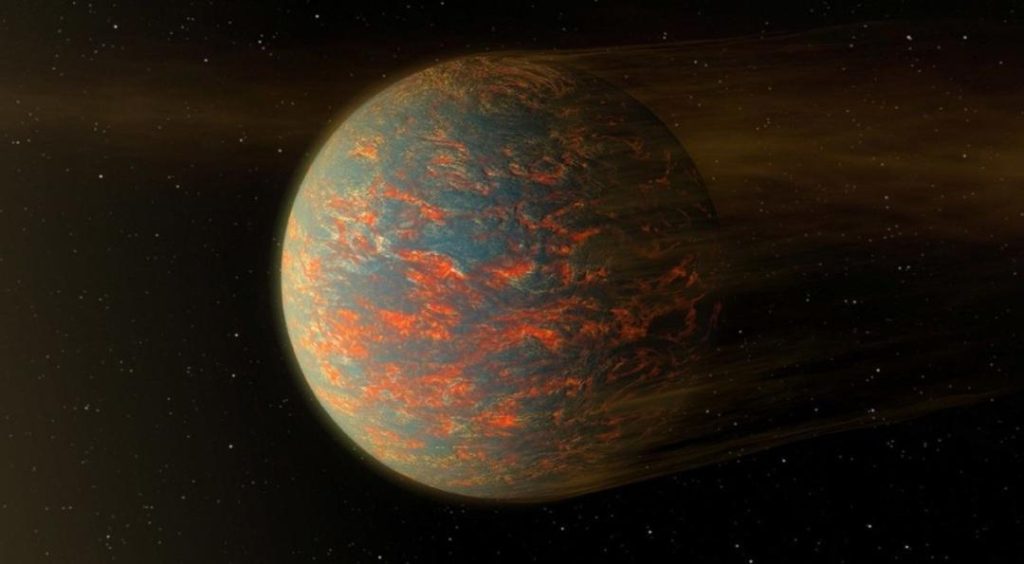
Newly-discovered super-Earth heats up & freezes every 300 days
In a groundbreaking discovery, scientists have found a new “super-Earth” orbiting a Sun-like star just 20 light-years from our planet. This newly-discovered exoplanet is unlike any other, as it experiences extreme heat for the first part of its year and then freezes for the rest of the days. This bizarre climate pattern occurs due to its unique oval-shaped orbit, causing the planet to swing between scorching hot and icy cold temperatures roughly every 300 days.
The discovery of this super-Earth has sent shockwaves throughout the scientific community, with many experts excited to learn more about this peculiar planet. But what makes this exoplanet so special, and what can we learn from its extreme climate fluctuations? In this blog post, we’ll delve into the details of this fascinating finding and explore the implications for our understanding of planetary formation and the search for life beyond Earth.
What is a super-Earth?
Before we dive into the specifics of this newly-discovered exoplanet, let’s first define what a super-Earth is. A super-Earth is a type of exoplanet that is larger than our own Earth but smaller than the gas giants like Neptune and Uranus. These planets are typically classified as “terrestrial” because they are thought to have rocky compositions and solid surfaces, unlike the gas giants which are primarily composed of hydrogen and helium.
Super-Earths are of great interest to scientists because they may offer the perfect conditions for life to thrive. Not only are they larger than Earth, but they also have more mass, which means they can retain more heat and maintain a stable atmosphere. This makes them prime candidates for hosting liquid water and potentially supporting life.
The discovery of the new super-Earth
The new super-Earth was discovered using NASA’s Transiting Exoplanet Survey Satellite (TESS). TESS is a space telescope designed to monitor the brightness of nearby stars for any changes that could indicate the presence of an exoplanet passing in front of it. The satellite uses the transit method, which involves measuring the decrease in brightness of a star as a planet passes in front of it.
In this case, the new super-Earth, which has been named K2-141b, was discovered by monitoring the brightness of its host star, K2-141. The star is a G-type main-sequence star, similar to our own Sun, and is located about 20 light-years from Earth in the constellation of Libra.
The extreme climate of K2-141b
So, what makes K2-141b so unique? The answer lies in its incredible orbit, which is unlike anything seen before. The planet takes around 300 days to complete one orbit around its host star, but its path is not a perfect circle. Instead, it follows an oval shape, which means it spends part of its year closer to the star than others.
As a result, K2-141b experiences extreme heat for the first part of its year, with surface temperatures reaching as high as 2,000°F (1,093°C). This is due to the intense radiation it receives from its host star, which is similar to the amount of energy our own Sun emits. However, as the planet moves further away from the star, it begins to cool down rapidly, reaching temperatures as low as -200°F (-129°C) in the second half of its year.
This extreme climate fluctuation is unprecedented in our solar system, where planets typically experience a more stable and consistent temperature range. The discovery of K2-141b offers a unique opportunity for scientists to study the effects of such extreme climate conditions on a planetary surface.
Implications for planetary formation and the search for life
The discovery of K2-141b has significant implications for our understanding of planetary formation and the search for life beyond Earth. The extreme climate fluctuations on K2-141b suggest that the planet may have formed through a different process than our own Earth, which could provide valuable insights into the diversity of planetary formation processes in the universe.
Furthermore, the discovery of a super-Earth with such extreme climate conditions raises questions about the potential for life on this planet. While the surface temperatures may be inhospitable for most known forms of life, the presence of liquid water and a stable atmosphere could still support life forms that are adapted to these extreme conditions.
Conclusion
The discovery of K2-141b, a super-Earth that heats up and freezes every 300 days, is a significant breakthrough in the field of exoplanetary science. This unique planet offers a fascinating opportunity for scientists to study the effects of extreme climate conditions on a planetary surface and to explore the potential for life on a planet with such extreme temperature fluctuations.
As we continue to explore the universe and discover new exoplanets, we may uncover even more bizarre and fascinating worlds, each with its own unique characteristics and implications for our understanding of planetary formation and the search for life beyond Earth.






